Continuous Quality Improvement Organizations in American Healthcare
VerifiedAdded on 2023/06/04
|10
|2590
|459
Essay
AI Summary
This essay delves into the realm of Quality Improvement Organizations (QIOs) and their crucial role in the American healthcare system. It begins with a definition of QIOs, emphasizing their composition of healthcare experts and their commitment to enhancing safety, delivery, and efficiency. The essay traces the historical evolution of QIOs, starting from their inception in 1965 and their transformation from Peer Review Organizations to their current form. It explores their functions, including data analysis, improvement identification, and their focus on specific diseases like diabetes. The essay also examines the statutory authority governing QIOs, referencing the Social Security Act and related regulations. Furthermore, it highlights the Agency for Healthcare Research and Quality and its research contributions. The essay then discusses specific programs like "Everyone with Diabetes Counts" and their impact on healthcare quality. The contribution of QIOs towards healthcare quality in America is also discussed, followed by reasons for the low ranking of the American healthcare system. The essay concludes by emphasizing the significance of QIOs and their ongoing efforts to improve healthcare outcomes and patient satisfaction, while also acknowledging the need for continuous improvement and adaptation to current technologies. This essay is a comprehensive overview of QIOs and their impact on the American healthcare landscape.
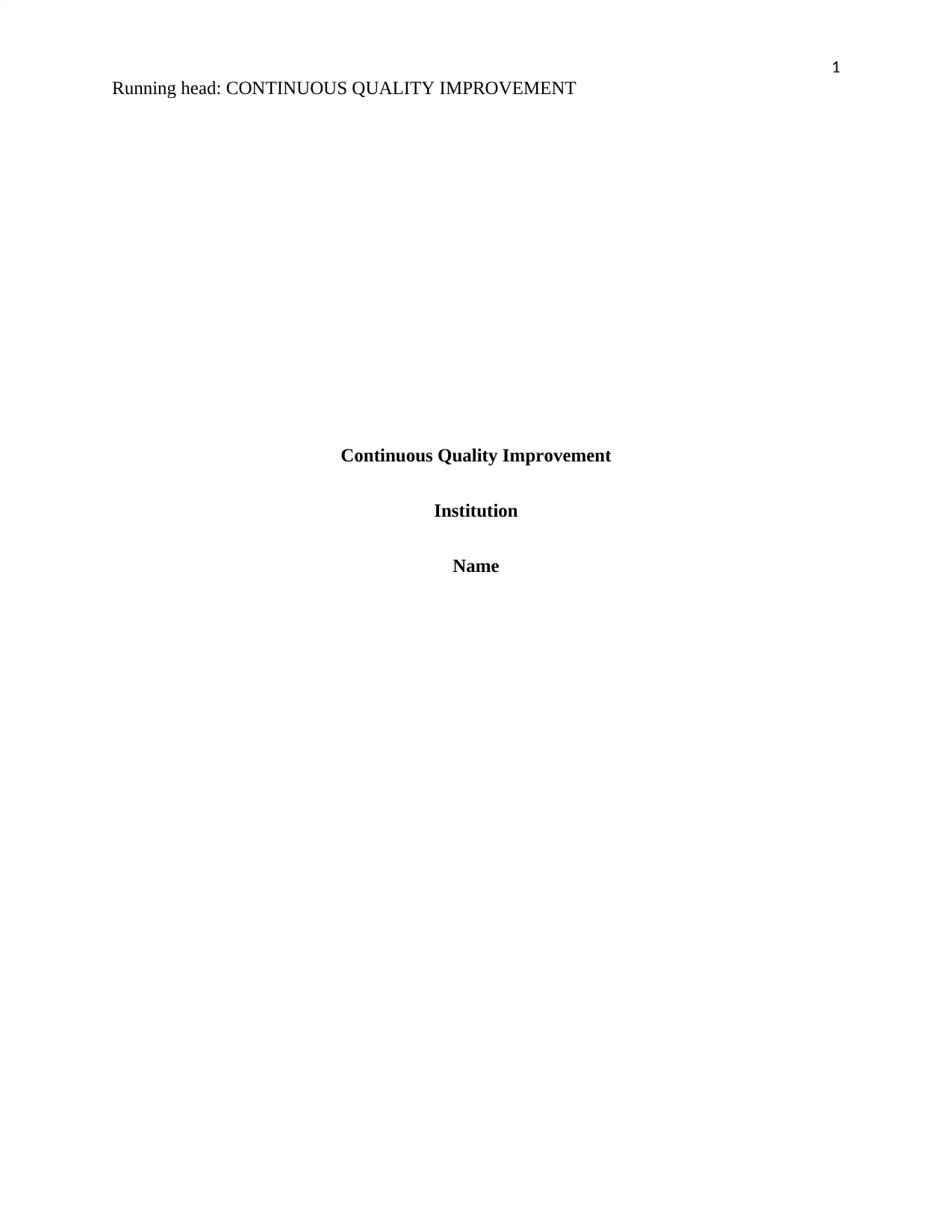
1
Running head: CONTINUOUS QUALITY IMPROVEMENT
Continuous Quality Improvement
Institution
Name
Running head: CONTINUOUS QUALITY IMPROVEMENT
Continuous Quality Improvement
Institution
Name
Paraphrase This Document
Need a fresh take? Get an instant paraphrase of this document with our AI Paraphraser
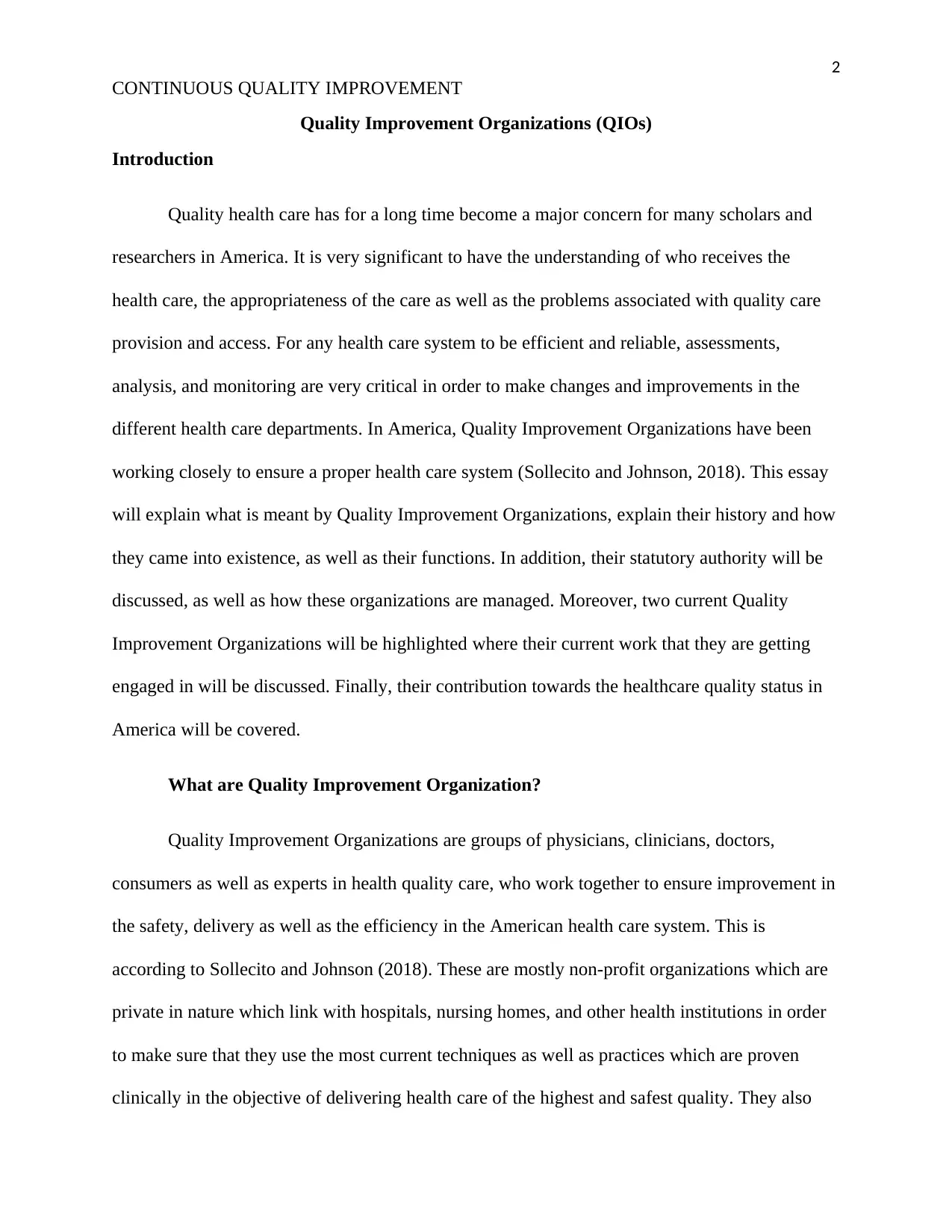
2
CONTINUOUS QUALITY IMPROVEMENT
Quality Improvement Organizations (QIOs)
Introduction
Quality health care has for a long time become a major concern for many scholars and
researchers in America. It is very significant to have the understanding of who receives the
health care, the appropriateness of the care as well as the problems associated with quality care
provision and access. For any health care system to be efficient and reliable, assessments,
analysis, and monitoring are very critical in order to make changes and improvements in the
different health care departments. In America, Quality Improvement Organizations have been
working closely to ensure a proper health care system (Sollecito and Johnson, 2018). This essay
will explain what is meant by Quality Improvement Organizations, explain their history and how
they came into existence, as well as their functions. In addition, their statutory authority will be
discussed, as well as how these organizations are managed. Moreover, two current Quality
Improvement Organizations will be highlighted where their current work that they are getting
engaged in will be discussed. Finally, their contribution towards the healthcare quality status in
America will be covered.
What are Quality Improvement Organization?
Quality Improvement Organizations are groups of physicians, clinicians, doctors,
consumers as well as experts in health quality care, who work together to ensure improvement in
the safety, delivery as well as the efficiency in the American health care system. This is
according to Sollecito and Johnson (2018). These are mostly non-profit organizations which are
private in nature which link with hospitals, nursing homes, and other health institutions in order
to make sure that they use the most current techniques as well as practices which are proven
clinically in the objective of delivering health care of the highest and safest quality. They also
CONTINUOUS QUALITY IMPROVEMENT
Quality Improvement Organizations (QIOs)
Introduction
Quality health care has for a long time become a major concern for many scholars and
researchers in America. It is very significant to have the understanding of who receives the
health care, the appropriateness of the care as well as the problems associated with quality care
provision and access. For any health care system to be efficient and reliable, assessments,
analysis, and monitoring are very critical in order to make changes and improvements in the
different health care departments. In America, Quality Improvement Organizations have been
working closely to ensure a proper health care system (Sollecito and Johnson, 2018). This essay
will explain what is meant by Quality Improvement Organizations, explain their history and how
they came into existence, as well as their functions. In addition, their statutory authority will be
discussed, as well as how these organizations are managed. Moreover, two current Quality
Improvement Organizations will be highlighted where their current work that they are getting
engaged in will be discussed. Finally, their contribution towards the healthcare quality status in
America will be covered.
What are Quality Improvement Organization?
Quality Improvement Organizations are groups of physicians, clinicians, doctors,
consumers as well as experts in health quality care, who work together to ensure improvement in
the safety, delivery as well as the efficiency in the American health care system. This is
according to Sollecito and Johnson (2018). These are mostly non-profit organizations which are
private in nature which link with hospitals, nursing homes, and other health institutions in order
to make sure that they use the most current techniques as well as practices which are proven
clinically in the objective of delivering health care of the highest and safest quality. They also
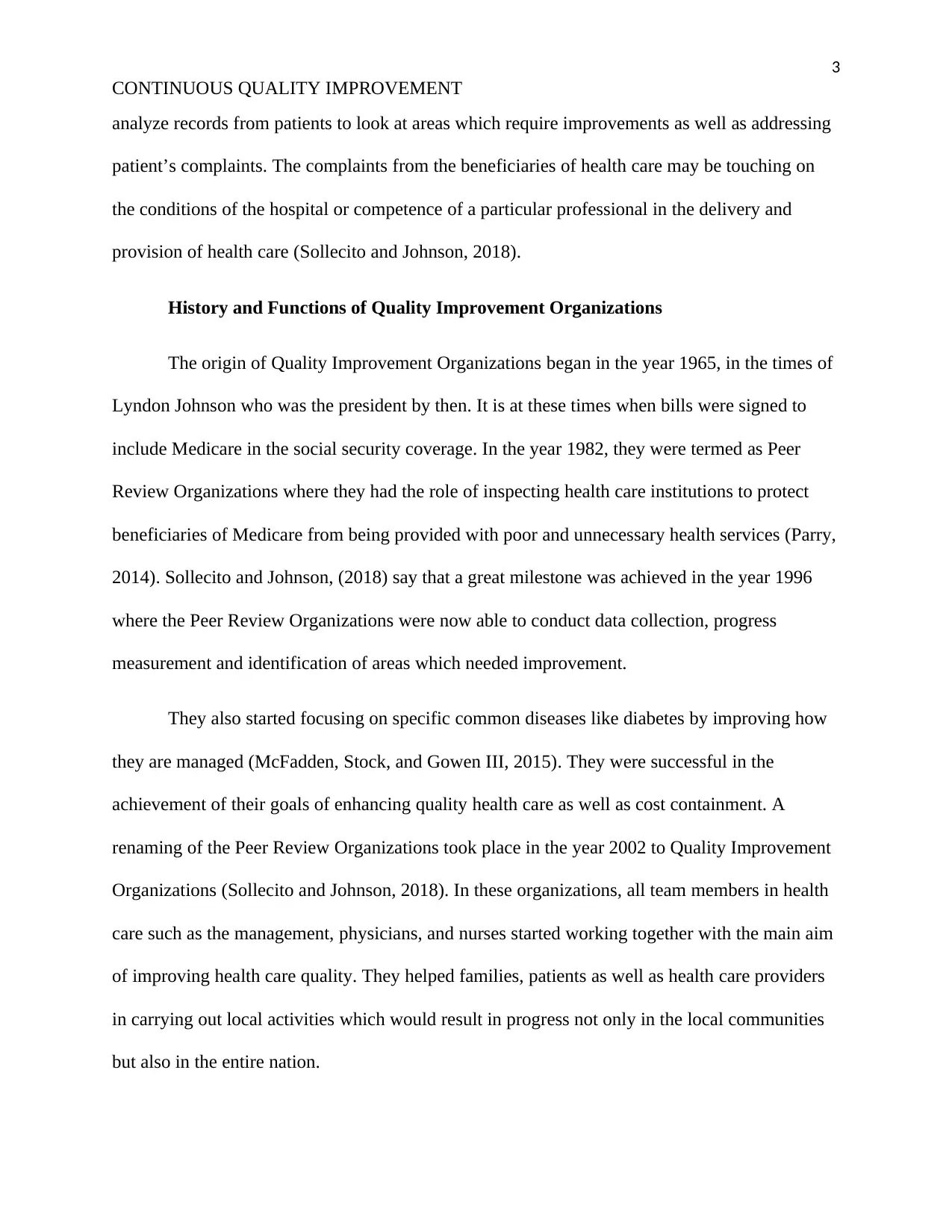
3
CONTINUOUS QUALITY IMPROVEMENT
analyze records from patients to look at areas which require improvements as well as addressing
patient’s complaints. The complaints from the beneficiaries of health care may be touching on
the conditions of the hospital or competence of a particular professional in the delivery and
provision of health care (Sollecito and Johnson, 2018).
History and Functions of Quality Improvement Organizations
The origin of Quality Improvement Organizations began in the year 1965, in the times of
Lyndon Johnson who was the president by then. It is at these times when bills were signed to
include Medicare in the social security coverage. In the year 1982, they were termed as Peer
Review Organizations where they had the role of inspecting health care institutions to protect
beneficiaries of Medicare from being provided with poor and unnecessary health services (Parry,
2014). Sollecito and Johnson, (2018) say that a great milestone was achieved in the year 1996
where the Peer Review Organizations were now able to conduct data collection, progress
measurement and identification of areas which needed improvement.
They also started focusing on specific common diseases like diabetes by improving how
they are managed (McFadden, Stock, and Gowen III, 2015). They were successful in the
achievement of their goals of enhancing quality health care as well as cost containment. A
renaming of the Peer Review Organizations took place in the year 2002 to Quality Improvement
Organizations (Sollecito and Johnson, 2018). In these organizations, all team members in health
care such as the management, physicians, and nurses started working together with the main aim
of improving health care quality. They helped families, patients as well as health care providers
in carrying out local activities which would result in progress not only in the local communities
but also in the entire nation.
CONTINUOUS QUALITY IMPROVEMENT
analyze records from patients to look at areas which require improvements as well as addressing
patient’s complaints. The complaints from the beneficiaries of health care may be touching on
the conditions of the hospital or competence of a particular professional in the delivery and
provision of health care (Sollecito and Johnson, 2018).
History and Functions of Quality Improvement Organizations
The origin of Quality Improvement Organizations began in the year 1965, in the times of
Lyndon Johnson who was the president by then. It is at these times when bills were signed to
include Medicare in the social security coverage. In the year 1982, they were termed as Peer
Review Organizations where they had the role of inspecting health care institutions to protect
beneficiaries of Medicare from being provided with poor and unnecessary health services (Parry,
2014). Sollecito and Johnson, (2018) say that a great milestone was achieved in the year 1996
where the Peer Review Organizations were now able to conduct data collection, progress
measurement and identification of areas which needed improvement.
They also started focusing on specific common diseases like diabetes by improving how
they are managed (McFadden, Stock, and Gowen III, 2015). They were successful in the
achievement of their goals of enhancing quality health care as well as cost containment. A
renaming of the Peer Review Organizations took place in the year 2002 to Quality Improvement
Organizations (Sollecito and Johnson, 2018). In these organizations, all team members in health
care such as the management, physicians, and nurses started working together with the main aim
of improving health care quality. They helped families, patients as well as health care providers
in carrying out local activities which would result in progress not only in the local communities
but also in the entire nation.
⊘ This is a preview!⊘
Do you want full access?
Subscribe today to unlock all pages.

Trusted by 1+ million students worldwide

4
CONTINUOUS QUALITY IMPROVEMENT
Statutory Authority for Quality Improvement Organizations
In the statutory authorities governing the Quality Improvement Organizations, Section
1154(a) (18) of the Social Security Act, the organization is supposed to perform and remain in
the roles and objectives that are stated, adhering to the terms and conditions of the contract
(Jencks, 2013). Activities which may be taken by the organizations to improve the quality of
health care, as long as they are efficient and reasonable are supposed to be paid for in reference
to title XVIII of the Social Security Act. A patient who has a problem which requires care
improvement can be allowed to be handled by the Quality Improvement Organizations for the
purpose of assessing, analyzing, intervening as well as resolving the problem and making a
follow-up, according to the definition in Article 42, Part 480, Section 101 of the Social Security
Act. 42 CFR 476. 1 defines quality initiative as any activity designed for the purpose of
improving health care quality by using proven methodologies (Jencks and Wilensky, 2013). The
improvement initiative should involve communities, practitioners, beneficiaries and health care
providers where the aim of the improvement should relate to cost containment, safety, and health
care.
In Section 1160(a) (3) of 480. 103, Quality Improvement Organizations are required by
the Act to maintain evidence concerning the health care services provided to Medicare patients.
Section 1160 states that confidentiality and disclosure of information regarding Quality
Improvement Organizations should be maintained in the best way possible where exceptions are
outlined in Title XI Part B of the Act (Jencks and Wilensky, 2013). Any person who discloses
any information which is not outlined in the exceptions will suffer the consequences upon
conviction including a fine of not more than $1000, or imprisonment of not more than six
CONTINUOUS QUALITY IMPROVEMENT
Statutory Authority for Quality Improvement Organizations
In the statutory authorities governing the Quality Improvement Organizations, Section
1154(a) (18) of the Social Security Act, the organization is supposed to perform and remain in
the roles and objectives that are stated, adhering to the terms and conditions of the contract
(Jencks, 2013). Activities which may be taken by the organizations to improve the quality of
health care, as long as they are efficient and reasonable are supposed to be paid for in reference
to title XVIII of the Social Security Act. A patient who has a problem which requires care
improvement can be allowed to be handled by the Quality Improvement Organizations for the
purpose of assessing, analyzing, intervening as well as resolving the problem and making a
follow-up, according to the definition in Article 42, Part 480, Section 101 of the Social Security
Act. 42 CFR 476. 1 defines quality initiative as any activity designed for the purpose of
improving health care quality by using proven methodologies (Jencks and Wilensky, 2013). The
improvement initiative should involve communities, practitioners, beneficiaries and health care
providers where the aim of the improvement should relate to cost containment, safety, and health
care.
In Section 1160(a) (3) of 480. 103, Quality Improvement Organizations are required by
the Act to maintain evidence concerning the health care services provided to Medicare patients.
Section 1160 states that confidentiality and disclosure of information regarding Quality
Improvement Organizations should be maintained in the best way possible where exceptions are
outlined in Title XI Part B of the Act (Jencks and Wilensky, 2013). Any person who discloses
any information which is not outlined in the exceptions will suffer the consequences upon
conviction including a fine of not more than $1000, or imprisonment of not more than six
Paraphrase This Document
Need a fresh take? Get an instant paraphrase of this document with our AI Paraphraser
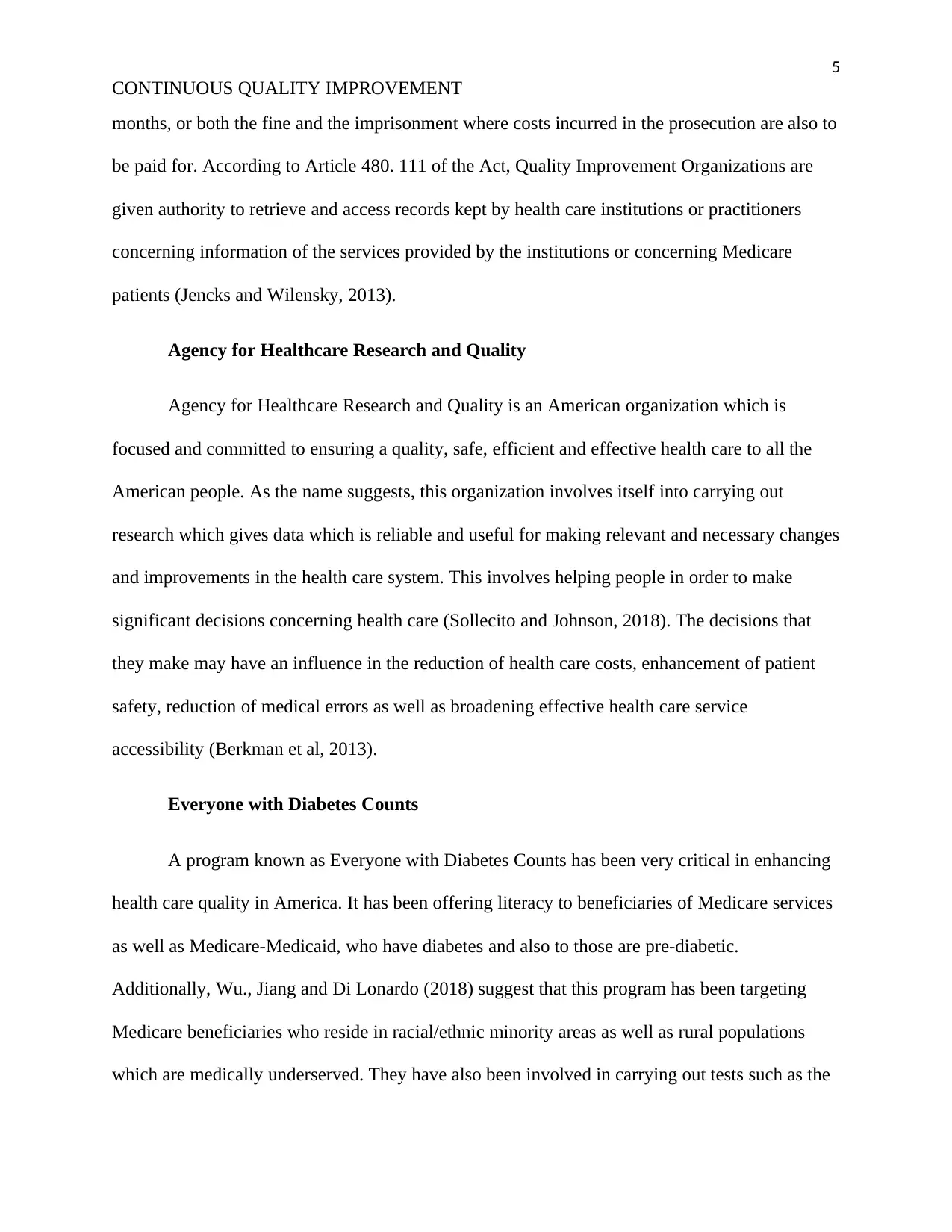
5
CONTINUOUS QUALITY IMPROVEMENT
months, or both the fine and the imprisonment where costs incurred in the prosecution are also to
be paid for. According to Article 480. 111 of the Act, Quality Improvement Organizations are
given authority to retrieve and access records kept by health care institutions or practitioners
concerning information of the services provided by the institutions or concerning Medicare
patients (Jencks and Wilensky, 2013).
Agency for Healthcare Research and Quality
Agency for Healthcare Research and Quality is an American organization which is
focused and committed to ensuring a quality, safe, efficient and effective health care to all the
American people. As the name suggests, this organization involves itself into carrying out
research which gives data which is reliable and useful for making relevant and necessary changes
and improvements in the health care system. This involves helping people in order to make
significant decisions concerning health care (Sollecito and Johnson, 2018). The decisions that
they make may have an influence in the reduction of health care costs, enhancement of patient
safety, reduction of medical errors as well as broadening effective health care service
accessibility (Berkman et al, 2013).
Everyone with Diabetes Counts
A program known as Everyone with Diabetes Counts has been very critical in enhancing
health care quality in America. It has been offering literacy to beneficiaries of Medicare services
as well as Medicare-Medicaid, who have diabetes and also to those are pre-diabetic.
Additionally, Wu., Jiang and Di Lonardo (2018) suggest that this program has been targeting
Medicare beneficiaries who reside in racial/ethnic minority areas as well as rural populations
which are medically underserved. They have also been involved in carrying out tests such as the
CONTINUOUS QUALITY IMPROVEMENT
months, or both the fine and the imprisonment where costs incurred in the prosecution are also to
be paid for. According to Article 480. 111 of the Act, Quality Improvement Organizations are
given authority to retrieve and access records kept by health care institutions or practitioners
concerning information of the services provided by the institutions or concerning Medicare
patients (Jencks and Wilensky, 2013).
Agency for Healthcare Research and Quality
Agency for Healthcare Research and Quality is an American organization which is
focused and committed to ensuring a quality, safe, efficient and effective health care to all the
American people. As the name suggests, this organization involves itself into carrying out
research which gives data which is reliable and useful for making relevant and necessary changes
and improvements in the health care system. This involves helping people in order to make
significant decisions concerning health care (Sollecito and Johnson, 2018). The decisions that
they make may have an influence in the reduction of health care costs, enhancement of patient
safety, reduction of medical errors as well as broadening effective health care service
accessibility (Berkman et al, 2013).
Everyone with Diabetes Counts
A program known as Everyone with Diabetes Counts has been very critical in enhancing
health care quality in America. It has been offering literacy to beneficiaries of Medicare services
as well as Medicare-Medicaid, who have diabetes and also to those are pre-diabetic.
Additionally, Wu., Jiang and Di Lonardo (2018) suggest that this program has been targeting
Medicare beneficiaries who reside in racial/ethnic minority areas as well as rural populations
which are medically underserved. They have also been involved in carrying out tests such as the
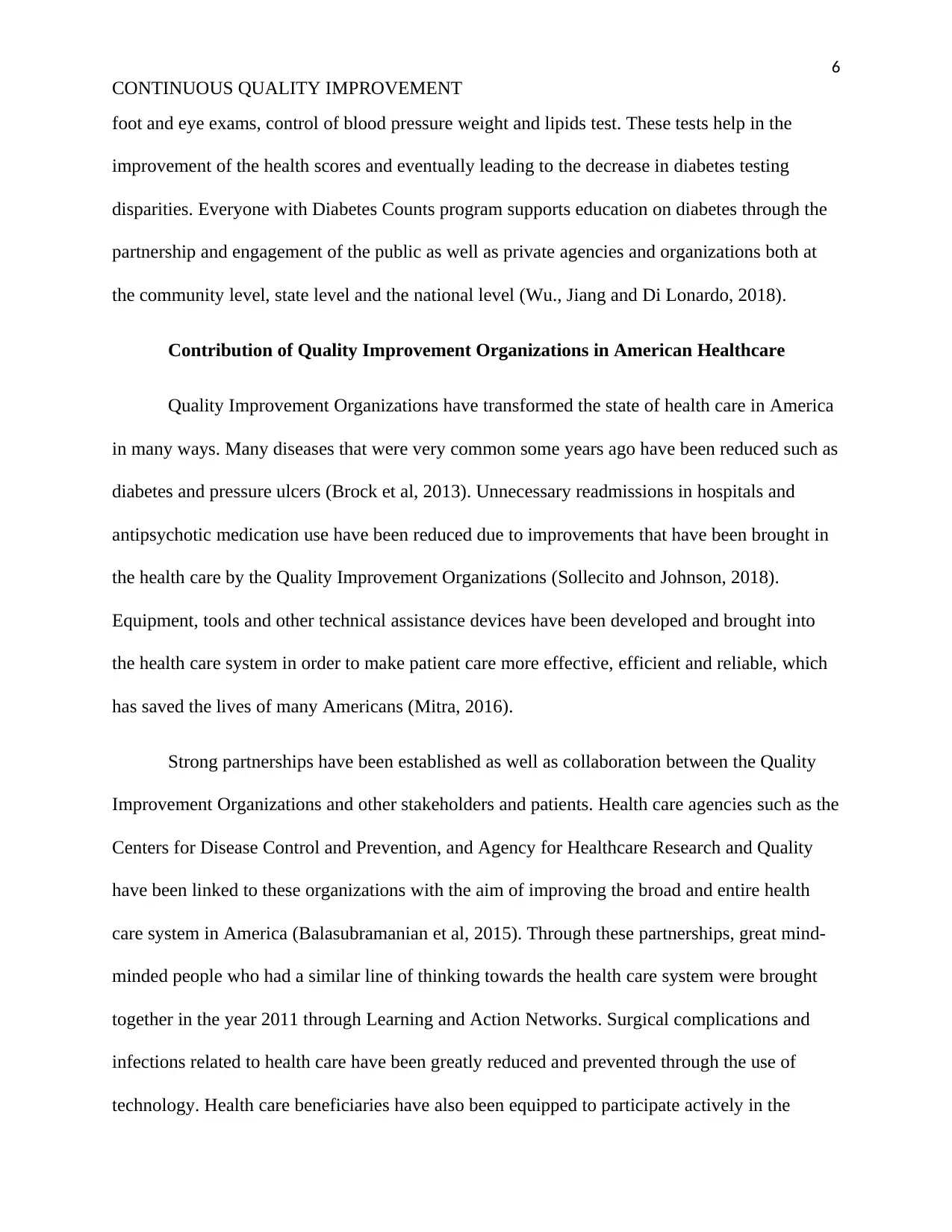
6
CONTINUOUS QUALITY IMPROVEMENT
foot and eye exams, control of blood pressure weight and lipids test. These tests help in the
improvement of the health scores and eventually leading to the decrease in diabetes testing
disparities. Everyone with Diabetes Counts program supports education on diabetes through the
partnership and engagement of the public as well as private agencies and organizations both at
the community level, state level and the national level (Wu., Jiang and Di Lonardo, 2018).
Contribution of Quality Improvement Organizations in American Healthcare
Quality Improvement Organizations have transformed the state of health care in America
in many ways. Many diseases that were very common some years ago have been reduced such as
diabetes and pressure ulcers (Brock et al, 2013). Unnecessary readmissions in hospitals and
antipsychotic medication use have been reduced due to improvements that have been brought in
the health care by the Quality Improvement Organizations (Sollecito and Johnson, 2018).
Equipment, tools and other technical assistance devices have been developed and brought into
the health care system in order to make patient care more effective, efficient and reliable, which
has saved the lives of many Americans (Mitra, 2016).
Strong partnerships have been established as well as collaboration between the Quality
Improvement Organizations and other stakeholders and patients. Health care agencies such as the
Centers for Disease Control and Prevention, and Agency for Healthcare Research and Quality
have been linked to these organizations with the aim of improving the broad and entire health
care system in America (Balasubramanian et al, 2015). Through these partnerships, great mind-
minded people who had a similar line of thinking towards the health care system were brought
together in the year 2011 through Learning and Action Networks. Surgical complications and
infections related to health care have been greatly reduced and prevented through the use of
technology. Health care beneficiaries have also been equipped to participate actively in the
CONTINUOUS QUALITY IMPROVEMENT
foot and eye exams, control of blood pressure weight and lipids test. These tests help in the
improvement of the health scores and eventually leading to the decrease in diabetes testing
disparities. Everyone with Diabetes Counts program supports education on diabetes through the
partnership and engagement of the public as well as private agencies and organizations both at
the community level, state level and the national level (Wu., Jiang and Di Lonardo, 2018).
Contribution of Quality Improvement Organizations in American Healthcare
Quality Improvement Organizations have transformed the state of health care in America
in many ways. Many diseases that were very common some years ago have been reduced such as
diabetes and pressure ulcers (Brock et al, 2013). Unnecessary readmissions in hospitals and
antipsychotic medication use have been reduced due to improvements that have been brought in
the health care by the Quality Improvement Organizations (Sollecito and Johnson, 2018).
Equipment, tools and other technical assistance devices have been developed and brought into
the health care system in order to make patient care more effective, efficient and reliable, which
has saved the lives of many Americans (Mitra, 2016).
Strong partnerships have been established as well as collaboration between the Quality
Improvement Organizations and other stakeholders and patients. Health care agencies such as the
Centers for Disease Control and Prevention, and Agency for Healthcare Research and Quality
have been linked to these organizations with the aim of improving the broad and entire health
care system in America (Balasubramanian et al, 2015). Through these partnerships, great mind-
minded people who had a similar line of thinking towards the health care system were brought
together in the year 2011 through Learning and Action Networks. Surgical complications and
infections related to health care have been greatly reduced and prevented through the use of
technology. Health care beneficiaries have also been equipped to participate actively in the
⊘ This is a preview!⊘
Do you want full access?
Subscribe today to unlock all pages.

Trusted by 1+ million students worldwide
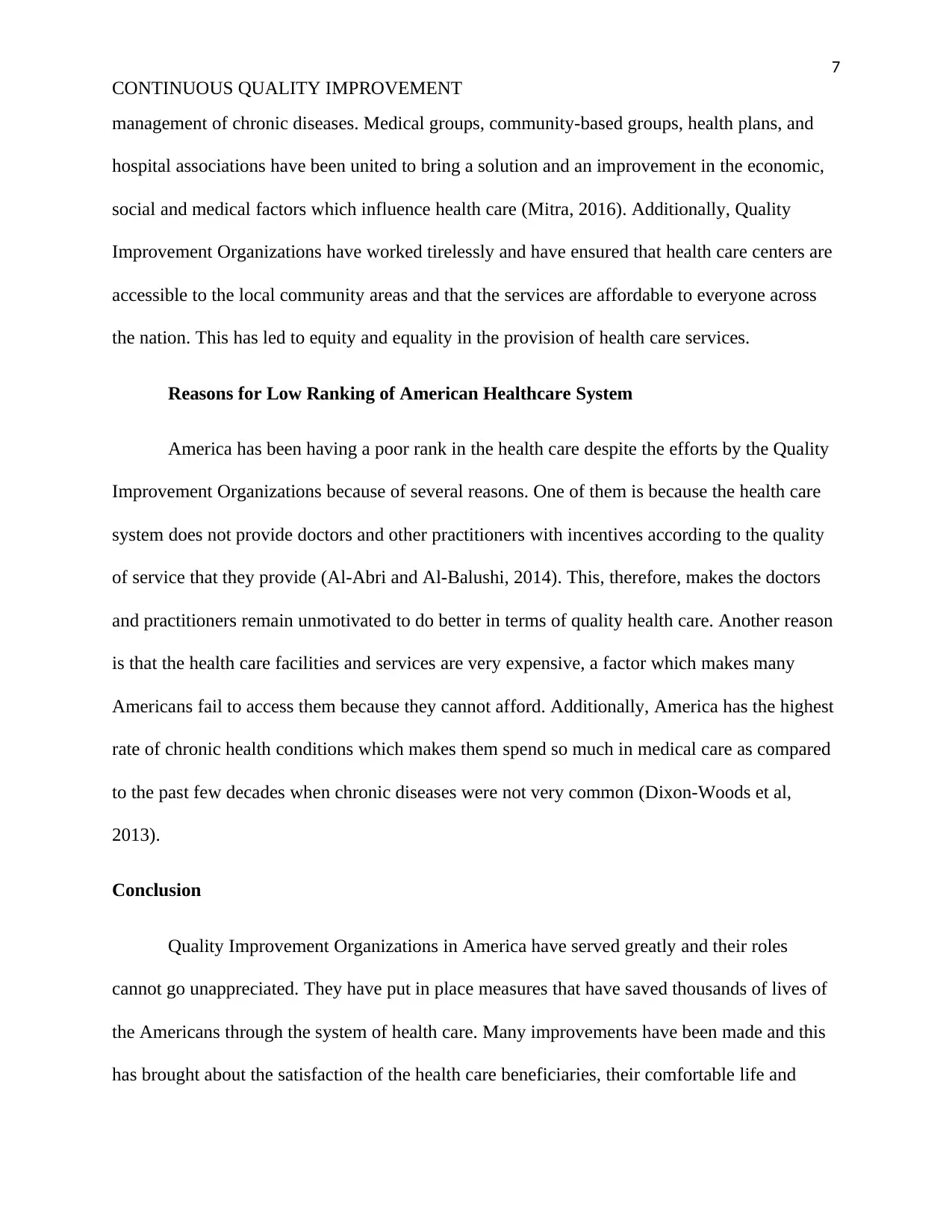
7
CONTINUOUS QUALITY IMPROVEMENT
management of chronic diseases. Medical groups, community-based groups, health plans, and
hospital associations have been united to bring a solution and an improvement in the economic,
social and medical factors which influence health care (Mitra, 2016). Additionally, Quality
Improvement Organizations have worked tirelessly and have ensured that health care centers are
accessible to the local community areas and that the services are affordable to everyone across
the nation. This has led to equity and equality in the provision of health care services.
Reasons for Low Ranking of American Healthcare System
America has been having a poor rank in the health care despite the efforts by the Quality
Improvement Organizations because of several reasons. One of them is because the health care
system does not provide doctors and other practitioners with incentives according to the quality
of service that they provide (Al-Abri and Al-Balushi, 2014). This, therefore, makes the doctors
and practitioners remain unmotivated to do better in terms of quality health care. Another reason
is that the health care facilities and services are very expensive, a factor which makes many
Americans fail to access them because they cannot afford. Additionally, America has the highest
rate of chronic health conditions which makes them spend so much in medical care as compared
to the past few decades when chronic diseases were not very common (Dixon-Woods et al,
2013).
Conclusion
Quality Improvement Organizations in America have served greatly and their roles
cannot go unappreciated. They have put in place measures that have saved thousands of lives of
the Americans through the system of health care. Many improvements have been made and this
has brought about the satisfaction of the health care beneficiaries, their comfortable life and
CONTINUOUS QUALITY IMPROVEMENT
management of chronic diseases. Medical groups, community-based groups, health plans, and
hospital associations have been united to bring a solution and an improvement in the economic,
social and medical factors which influence health care (Mitra, 2016). Additionally, Quality
Improvement Organizations have worked tirelessly and have ensured that health care centers are
accessible to the local community areas and that the services are affordable to everyone across
the nation. This has led to equity and equality in the provision of health care services.
Reasons for Low Ranking of American Healthcare System
America has been having a poor rank in the health care despite the efforts by the Quality
Improvement Organizations because of several reasons. One of them is because the health care
system does not provide doctors and other practitioners with incentives according to the quality
of service that they provide (Al-Abri and Al-Balushi, 2014). This, therefore, makes the doctors
and practitioners remain unmotivated to do better in terms of quality health care. Another reason
is that the health care facilities and services are very expensive, a factor which makes many
Americans fail to access them because they cannot afford. Additionally, America has the highest
rate of chronic health conditions which makes them spend so much in medical care as compared
to the past few decades when chronic diseases were not very common (Dixon-Woods et al,
2013).
Conclusion
Quality Improvement Organizations in America have served greatly and their roles
cannot go unappreciated. They have put in place measures that have saved thousands of lives of
the Americans through the system of health care. Many improvements have been made and this
has brought about the satisfaction of the health care beneficiaries, their comfortable life and
Paraphrase This Document
Need a fresh take? Get an instant paraphrase of this document with our AI Paraphraser
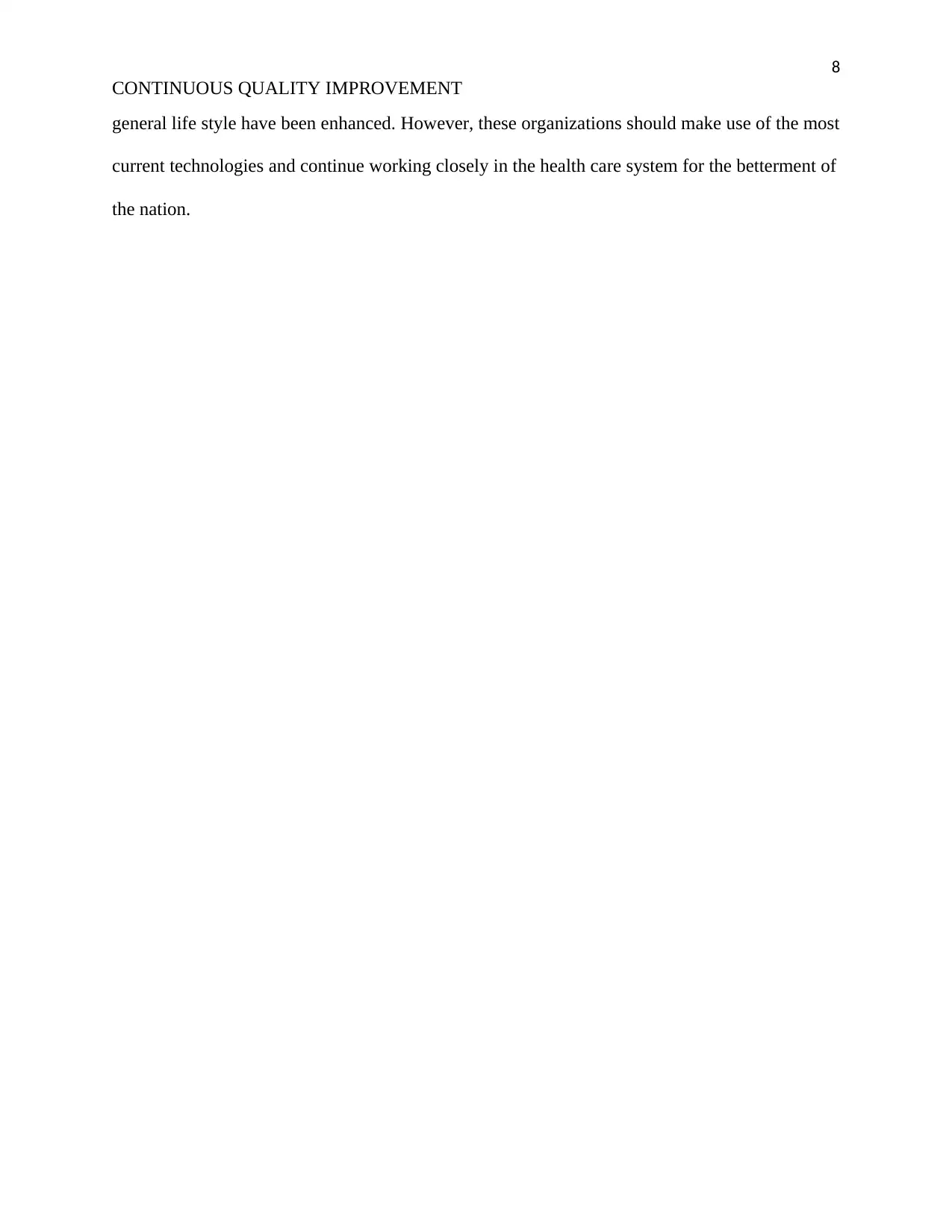
8
CONTINUOUS QUALITY IMPROVEMENT
general life style have been enhanced. However, these organizations should make use of the most
current technologies and continue working closely in the health care system for the betterment of
the nation.
CONTINUOUS QUALITY IMPROVEMENT
general life style have been enhanced. However, these organizations should make use of the most
current technologies and continue working closely in the health care system for the betterment of
the nation.
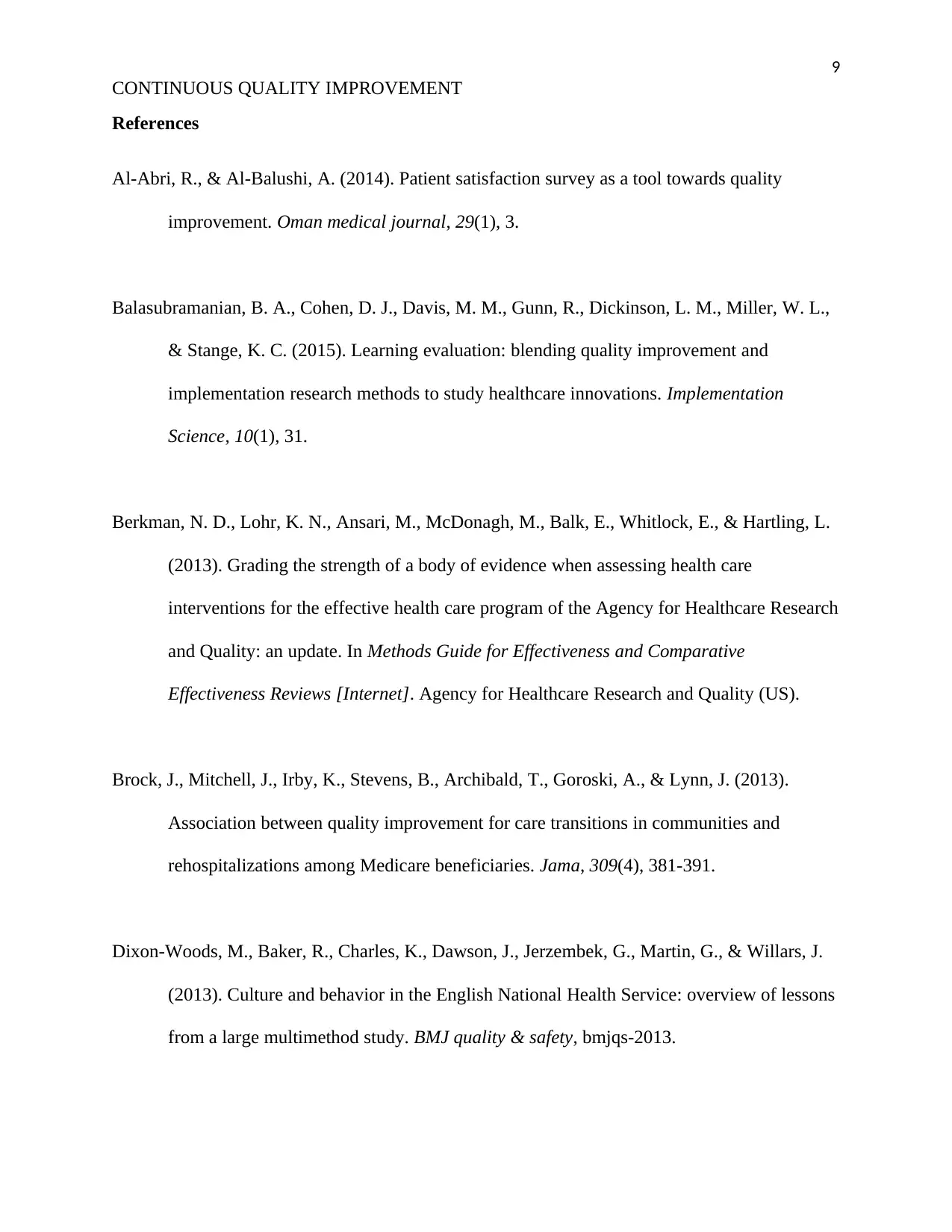
9
CONTINUOUS QUALITY IMPROVEMENT
References
Al-Abri, R., & Al-Balushi, A. (2014). Patient satisfaction survey as a tool towards quality
improvement. Oman medical journal, 29(1), 3.
Balasubramanian, B. A., Cohen, D. J., Davis, M. M., Gunn, R., Dickinson, L. M., Miller, W. L.,
& Stange, K. C. (2015). Learning evaluation: blending quality improvement and
implementation research methods to study healthcare innovations. Implementation
Science, 10(1), 31.
Berkman, N. D., Lohr, K. N., Ansari, M., McDonagh, M., Balk, E., Whitlock, E., & Hartling, L.
(2013). Grading the strength of a body of evidence when assessing health care
interventions for the effective health care program of the Agency for Healthcare Research
and Quality: an update. In Methods Guide for Effectiveness and Comparative
Effectiveness Reviews [Internet]. Agency for Healthcare Research and Quality (US).
Brock, J., Mitchell, J., Irby, K., Stevens, B., Archibald, T., Goroski, A., & Lynn, J. (2013).
Association between quality improvement for care transitions in communities and
rehospitalizations among Medicare beneficiaries. Jama, 309(4), 381-391.
Dixon-Woods, M., Baker, R., Charles, K., Dawson, J., Jerzembek, G., Martin, G., & Willars, J.
(2013). Culture and behavior in the English National Health Service: overview of lessons
from a large multimethod study. BMJ quality & safety, bmjqs-2013.
CONTINUOUS QUALITY IMPROVEMENT
References
Al-Abri, R., & Al-Balushi, A. (2014). Patient satisfaction survey as a tool towards quality
improvement. Oman medical journal, 29(1), 3.
Balasubramanian, B. A., Cohen, D. J., Davis, M. M., Gunn, R., Dickinson, L. M., Miller, W. L.,
& Stange, K. C. (2015). Learning evaluation: blending quality improvement and
implementation research methods to study healthcare innovations. Implementation
Science, 10(1), 31.
Berkman, N. D., Lohr, K. N., Ansari, M., McDonagh, M., Balk, E., Whitlock, E., & Hartling, L.
(2013). Grading the strength of a body of evidence when assessing health care
interventions for the effective health care program of the Agency for Healthcare Research
and Quality: an update. In Methods Guide for Effectiveness and Comparative
Effectiveness Reviews [Internet]. Agency for Healthcare Research and Quality (US).
Brock, J., Mitchell, J., Irby, K., Stevens, B., Archibald, T., Goroski, A., & Lynn, J. (2013).
Association between quality improvement for care transitions in communities and
rehospitalizations among Medicare beneficiaries. Jama, 309(4), 381-391.
Dixon-Woods, M., Baker, R., Charles, K., Dawson, J., Jerzembek, G., Martin, G., & Willars, J.
(2013). Culture and behavior in the English National Health Service: overview of lessons
from a large multimethod study. BMJ quality & safety, bmjqs-2013.
⊘ This is a preview!⊘
Do you want full access?
Subscribe today to unlock all pages.

Trusted by 1+ million students worldwide

10
CONTINUOUS QUALITY IMPROVEMENT
Jencks S.F, (2013). Quality Improvement Organizations and Hospital Care. Letter to the Editor.
Journal of the American Medical Association. 294(16), 2028.
Jencks S.F, Wilensky G.R (2013). The Health Care Quality Improvement Initiative: A New
Approach to Quality Assurance in Medicare. Journal of the American Medical
Association. 268(7), 900–903
McFadden, K. L., Stock, G. N., & Gowen III, C. R. (2015). Leadership, safety climate, and
continuous quality improvement: impact on process quality and patient safety. Health
care management review, 40(1), 24-34.
Mitra, A. (2016). Fundamentals of quality control and improvement. John Wiley & Sons.
Parry, G. J. (2014). A brief history of quality improvement. Journal of oncology practice, 10(3),
196-199.
Sollecito, W., & Johnson, J. K. (2018). McLaughlin and Kaluzny's continuous quality
improvement in health care. Jones & Bartlett Publishers.
Wu, W. Y., Jiang, Q., & Di Lonardo, S. S. (2018). Poorly controlled diabetes in New York City:
mapping high-density neighborhoods. Journal of Public Health Management and
Practice, 24(1), 69-74.
CONTINUOUS QUALITY IMPROVEMENT
Jencks S.F, (2013). Quality Improvement Organizations and Hospital Care. Letter to the Editor.
Journal of the American Medical Association. 294(16), 2028.
Jencks S.F, Wilensky G.R (2013). The Health Care Quality Improvement Initiative: A New
Approach to Quality Assurance in Medicare. Journal of the American Medical
Association. 268(7), 900–903
McFadden, K. L., Stock, G. N., & Gowen III, C. R. (2015). Leadership, safety climate, and
continuous quality improvement: impact on process quality and patient safety. Health
care management review, 40(1), 24-34.
Mitra, A. (2016). Fundamentals of quality control and improvement. John Wiley & Sons.
Parry, G. J. (2014). A brief history of quality improvement. Journal of oncology practice, 10(3),
196-199.
Sollecito, W., & Johnson, J. K. (2018). McLaughlin and Kaluzny's continuous quality
improvement in health care. Jones & Bartlett Publishers.
Wu, W. Y., Jiang, Q., & Di Lonardo, S. S. (2018). Poorly controlled diabetes in New York City:
mapping high-density neighborhoods. Journal of Public Health Management and
Practice, 24(1), 69-74.
1 out of 10
Related Documents
Your All-in-One AI-Powered Toolkit for Academic Success.
+13062052269
info@desklib.com
Available 24*7 on WhatsApp / Email
![[object Object]](/_next/static/media/star-bottom.7253800d.svg)
Unlock your academic potential
Copyright © 2020–2025 A2Z Services. All Rights Reserved. Developed and managed by ZUCOL.





